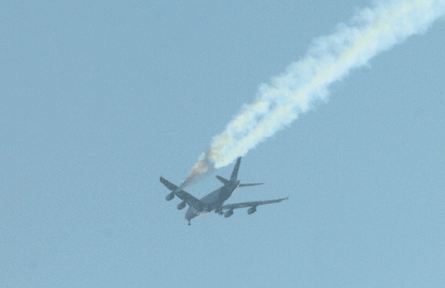Airbus's hoped-for relaxation in the International Civil Aviation Organisation's recommended separation distances for the A380 has been delayed because the manufacturer has only just completed in-flight wake-vortex trials.
Following ICAO's recommendations in October 2006 that the distance between the A380 and other aircraft should be larger than the standard for other large or "heavy" category aircraft, the airframer has been undertaking extensive back-to-back flight trials with the A380 and other aircraft to prove the advice was too conservative.
 |
|---|
© ABACA/PA PHOTOSRecent pictures of the A380 trailing smoke show it undertaking trials that were part of the original group of tests |
Airbus had planned to submit its detailed wake vortex data to ICAO for analysis in September 2007, and was confidently predicting that revised distances similar to those required for the Boeing 747 would be issued before the end of 2007, but it says this has been delayed as testing has been "ongoing".
Recent pictures of the A380 trailing smoke show it undertaking trials that were part of the original group of tests, which ran on longer than expected because of various issues, such as the availability of aircraft, says Airbus. "Testing has been completed in the last two weeks," it adds.
Airbus aims to pass the data to ICAO's wake vortex steering group in January 2008 but cannot be specific about when the revised distances will be issued. "It will take some time for ICAO to reach its final conclusions," it says. "An update on new separation distances is expected in the coming months."
The current ICAO arrival separation for the A380 is as follows: 4nm (7.4km) to another A380 6nm to a heavy (for example a 747) 8nm to a medium (an A320, for instance) and 10nm to light category aircraft. These are 2nm, 3nm and 4nm, respectively, greater than the separation recommended for heavy aircraft such as the 747.
It is important for the distances to be reduced before the in-service fleet expands significantly because closely-timed A380 arrivals at a congested airport such as London Heathrow could have a negative impact on air traffic flow.
Source: FlightGlobal.com























